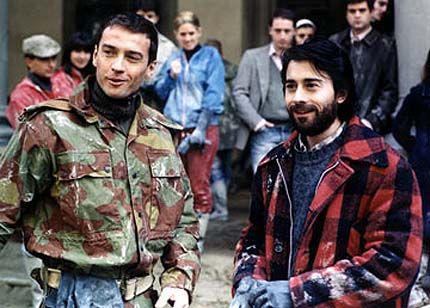 Marco Tullio Giordana’s The Best of Youth (2003) begins in 1966 with two brothers, Matteo and Nicola, at the end of another semester. After their final exams, they are to meet up with two of their buddies for a long road trip. Matteo, however, arrives with Giorgia, a girl whom he helped escape from the mental hospital where Matteo works. Giorgia has been abused while in custody, given severe doses of electroshock therapy that Matteo deplores. Postponing their trip for two days, Matteo and Nicola try to bring Giorgia to safety.
Marco Tullio Giordana’s The Best of Youth (2003) begins in 1966 with two brothers, Matteo and Nicola, at the end of another semester. After their final exams, they are to meet up with two of their buddies for a long road trip. Matteo, however, arrives with Giorgia, a girl whom he helped escape from the mental hospital where Matteo works. Giorgia has been abused while in custody, given severe doses of electroshock therapy that Matteo deplores. Postponing their trip for two days, Matteo and Nicola try to bring Giorgia to safety.They fail, however, and she is taken into custody by the police. Too, the brothers fail to go on their adventure: they never meet up with their friends, Matteo runs to join the military, and Nicola heads out on his own to Norway.
From the start, The Best of Youth structures its story on interruption, allowing for a whimsical feel that, for the most part, eludes feeling contrived and structured. That’s a hefty feet for such an epic film—it runs just over six hours—but a quality necessary for the film to succeed.
Much of its success it due to the writing by Sandro Petraglia and Sefano Rulli, who balance the audience’s want for drama, but also their plot-weary mentality. Brought up on movies, audiences can spot impossibilities like liver spots, and but for a few moments, the writing is sincere enough that even the best plot guessers won’t mind if they’re right, once in a while. The few moments I speak of are at the beginning of the second half, when the characters’ political alliances begin to clash: Matteo is with the police and Nicola’s wife is a member of the radical group the Red Brigades. However, this conflict doesn’t become the main focus of the film.
Instead, the film smartly focuses on family, playing close attention to every character and not allowing any of them to fall to the wayside. In many ways, The Best of Youth is similar to that other familial Italian epic The Tree of Wooden Clogs. That film, written and directed by Ermanno Olmi in 1978, tells the story a family of Italian peasants, working hard to make a living at the end start of the 20th century. Both films share a concentration to everyday survival, and the role that chance plays in determining our paths.
 Too, the film develops thematically, not relying on only one to permeate the film. Hours into the film, new themes continually re-assert themselves, harkening back to moments from early on in the film. Photography is a key element to the film. Matteo speaks of his own ideas about photographing people, and how one should look for the mystery in gestures, markings that might escape our eyes. Early on in the film, it is Matteo’s eye that noticed scars just above Giorgia’s ears, and it is his photographs of them that first engage Nicola’s sympathies for the girl.
Too, the film develops thematically, not relying on only one to permeate the film. Hours into the film, new themes continually re-assert themselves, harkening back to moments from early on in the film. Photography is a key element to the film. Matteo speaks of his own ideas about photographing people, and how one should look for the mystery in gestures, markings that might escape our eyes. Early on in the film, it is Matteo’s eye that noticed scars just above Giorgia’s ears, and it is his photographs of them that first engage Nicola’s sympathies for the girl.Director Giordana clearly shares this philosophy. Like Fellini, Giordana has a fondness for faces, and while they may not be as exaggerated as Fellini’s are, each character is given an individualistic look which helps distinguish them in such a long movie with so many different people.
Mental illness and politics all share time on screen, but the movie never falls back on didacticism for effect. They may surface throughout the film, but neither is the main point that The Best of Youth seems to be making. In fact, the point of the film is somewhat of a mystery that takes the whole film to fully evolve on screen. Ultimately, there are a lot of lessons that would sound hokey if I spelled them out to be found in The Best of Youth, but a pervasive capriciousness and pathos make them seem sincere—so that’s all right.
 In the end, we get the feeling that we have actually seen the characters in The Best of Youth live, and thinking back to the beginning of the film, forty years or six hours earlier (depending on how you judge time) seems a lifetime ago--which is the way its supposed to be.
In the end, we get the feeling that we have actually seen the characters in The Best of Youth live, and thinking back to the beginning of the film, forty years or six hours earlier (depending on how you judge time) seems a lifetime ago--which is the way its supposed to be.

No comments:
Post a Comment